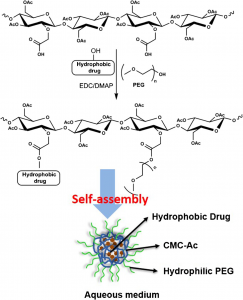Introduction- NanoCMC Drug Delivery Platform
Many nanoparticle systems formulate hydrophobic drugs via passive encapsulation. These nanoparticles often release the drugs rapidly due to efficient partition of the drugs to circulating plasma proteins, resulting in impaired pharmacokinetics and drug delivery. The NanoCMC polymer is composed of a hydrophobic drug and PEG conjugated via ester linkages to acetylated carboxymethylcellulose (Fig 1). The drug is carried by the polymer via a covalent bond, and therefore, the drug release is controlled, leading to improved pharmacokinetics and drug targeting. The docetaxel (DTX)-containing lead nanoparticle, Cellax, has demonstrated superior safety and efficacy compared to approved taxanes, including Taxotere® (native DTX) and Abraxane® (albumin-bound paclitaxel, the only FDA-approved taxane nanoparticle).
Figure 1: Schematic of Cellax synthesis. When the drug-to-PEG ratio is balanced, the polymer spontaneously condenses into a nanoparticle in aqueous systems. The carboxymethylcellulose backbone is acetylated to which we can attach the hydrophobic drug as well as PEG.